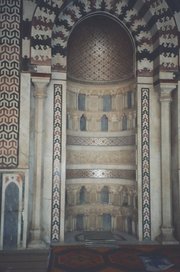Mihrab
|
|
Mihrab (in Persian مهراب or محراب, in Arabic ألمحراب pl. محاريب) is a niche in the wall of a mosque that indicates the qibla, i.e. the direction of Kaaba that Muslims should face when praying. The wall is called the qibla wall. The mihrab gives the impression of a door or a passage to Mecca. They vary in size but are usually ornately decorated. Mihrabs first appeared in the reign of the Umayyad khalif al-Walid I (705–715).

The etymology of the term is believed to come from the Persian word مهراب Mihrab which was used in pre-Islamic Persia to designate the niches in the Mithraistic houses of worship. Mihr in Persian means Mithra and Mihrab means Mithraeum. Others suggest that the root might be from Arabic حرب, "to fight" or "lead to war". As a noun it might be derived from "war", حرب and حربة , "lance". محراب is defined as a battlefield, in the sense jihād an-nafs (i.e. the fight against your own soul). Some say that it is also a word from Ethiopian or Hebrew חרבה, hurbah (beer) with a vague connection to the purchase to buildings. Both the latter guesses have less historical bearing and are less convincing than the first explanation.The mihrab is considered by both Muslim and Western scholars as an element taken from churches, an element added to the mosque of architectural reasons. The mihrab was probably introduced in the 3rd century of Islam, in the 9th century CE. Mihrabs can be made of wood, but is normally made out of masonry, and signified with pillars. Mihrabs very often are very ornamented.
Usage of Al-Mihrab in The Qur'an
In The Qur'anic context, the term Al-Mihrab is often used in conjunction with a rememberance of an event in life of prior (effectivley Jewish) servants of God. In these cases, the term indicates the "Holy of Holies" of the Mosque (1st and 2nd "Temple") in Jerusalem.
Examples are the relating of the story of Mary (PBUH) as a child in the "Al-Mihrab" where the Zacharriah (PBUH) was a Temple Priest (Q 3.37). Another instance is the apparition of the Angel fortelling the birth of John/Yahya (PBUH) to Zacharia (PBUH) (Q 19.1-19) which is also foretold in the Gospels as occuring "in the Holy of Holies". Based on other texts (The "Gospel of Pseudo-Matthew" and The Gospel of Christ according to Luke (Luke 1.11)), we can confirm that these 2 instances both refer to the "Holy of Holies" of the Jerusalem's (2nd) Temple.
The final such usage is in refernce to David (PBUH) and "disputants who climed into Al-Mihrab" (Q 38.21). Given that David did not build the Temple (Soloman (PBUH) did), but rather use temporary structures in its stead, we note that this may be refering to the "Holy of holies" of the termporary structure, which would also explain how the "disputants" manged to "climb in it".
This Qur'anic consideration of Al-Mihrab provides the amplification of the true meaning of 'Mihrab' -- regardless of its suspected "etymological roots"-- in Islamic faith and Architecture, when we note the progression of 'One central temple' to the distributed Mosques in communities.
The Mihrab then is a 'fragment of Holy of Holies' -- the place where, in the Temple Angels and Spirit descended on the Praying servants (i.e. priests). This 'fragment' or 'analogue' is then reproduced in all the places where men and women go to worship The One God.
I.e. Mihrab serves the same 'spatial-spiritual point' of 'meeting' between the 'community of God' and 'the Spirit' as the "Holy of Holies" served for the one 'Mosque' in Jerusalem.
See also: minbar See also: Qur'an
de:Mihrab es:Mihrab fr:Mihrab he:מיחרב ja:ミフラーブ nl:Mihrab pl:Mihrab
